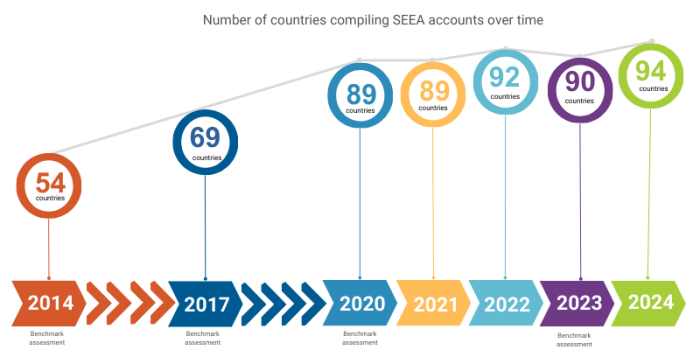
The Global Assessment of Environmental-Economic Accounting and Supporting Statistics is a survey administered under the auspices of the UN Committee of Experts on Environmental Economic Accounting (UNCEEA). The aim of the Global Assessment is to assess the progress of implementation of the SEEA in countries and to provide data for SDG indicator 15.9.1(in particular, sub-indicator 15.9.1 (b)). The Committee defines implementation in three progressive stages: 1) compilation (including pilot compilation); 2) compilation and dissemination; and 3) regular compilation and dissemination. More information on how the Committee views implementation can be found here.
The Assessment has previously been administered in 2014, 2017, 2020, 2021, 2022 and 2023 either as a benchmark or abbreviated assessment. Benchmark assessments serve to gain a detailed understanding of national SEEA implementation, including institutional and funding arrangements, countries’ priorities and future plans for implementing accounts, technical assistance received and provided, and the use of the accounts. Benchmark assessments have been administered every three years (2014, 2017, 2020, and 2023).
Abbreviated assessments are administered in non-benhmark years, and seek to obtain updates from respondents to the previous benchmark assessment and only collect updated information on new implementation and compilation activities. The first abbreviated assessment was run in 2021.
The 2024 Global Assessment was conducted as an abbreviated assessment. According to the results of the 2024 Global Assessment, 94 countries have implemented the SEEA. Of these 94 countries, 67 (71 per cent) publish at least one account on a regular basis (stage III); 10 (11 per cent) publish their accounts on an ad-hoc basis (stage II); while 17 countries (18 per cent) compile, but do not yet publish their accounts (stage I). All 94 countries compiling the SEEA compile SEEA Central Framework (SEEA CF) accounts while 53 also compile the SEEA Ecosystem Accounting (SEEA EA) and/or thematic accounts.

The number of countries implementing the SEEA has increased over the years, with brief periods of stagnation in implementation between 2020 and 2023. However, in 2024, there was an upward fluctuation with an increase in the number of countries adopting the SEEA framework. The vast majority of countries implementing the SEEA compile and diseminates he accounts in a regular basis.

Detailed country-by-country-by information from current and past global assessments:
- 2024 Global Assessment detailed country-by-country information.
- 2023 Global Assessment detailed country-by-country information.
- 2022 Global Assessment detailed country-by-country information.
- 2021 Global Assessment detailed country-by-country information.
- 2020 Global Assessment detailed country-by-country information.
Results of the 2006, 2008, 2014 and 2017 Global Assessments can be found here .
